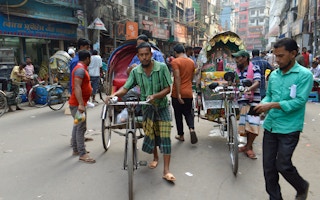With world temperature rise already 1°C above pre-industrial levels, new research shows that there is only a 0.5°C safety margin left in the system before the most vulnerable groups of people suffer severely.
The current political target, agreed in Paris more than two years ago, of aiming to prevent temperature from rising more than 1.5°C above pre-industrial levels, and certainly stopping a rise beyond 2°C, disguises the fact that we are already more than halfway to the danger point.
And scientists have now shown that there is a huge difference in the consequences to the human race if the 1.5°C limit is exceeded and temperatures allowed to reach 2°C.
Research to identify climate vulnerability hotspots has found that if the global temperature does rise by 2°C, then the number of people affected by multiple climate change risks could double the number affected by a rise of 1.5°C.
Because people living in poverty are much more vulnerable to climate change impacts, knowing where and how many of them are at high risk matters for developing policies to improve their lives.
The researchers investigated the overlap between socio-economic development and a range of climate change risks, to try to identify the vulnerability hotspots if the global mean temperature should rise by 1.5°C, 2°C or 3°C by 2050, compared with the pre-industrial baseline.
“
Few studies have consistently investigated so many overlapping climate and development challenges.
Edward Byers, International Institute for Applied Systems Analysis
The researchers are from the International Institute for Applied Systems Analysis (IIASA), the Global Environment Facility (GEF), the UN Industrial Development Organisation (UNIDO) and the universities of Oxford (UK) and Washington (US).
They report in the journal Environmental Research Letters that they developed 14 impact indicators in three main sectors – water, energy, and food and environment. These indicators include a water stress index, water supply seasonality, clean cooking access, heat stress events, habitat degradation, and crop yield changes.
The team compared the potential risks at the three selected temperatures and in a range of socio-economic pathways, to let them compare more equitable and sustainable development with pathways marked by development failures and high inequality.
Intolerable risk
In 2011, an estimated 767 million people were living on less than US$1.90 per day, classed as extreme poverty, and the researchers estimated that 3.5 billion more people were “vulnerable to poverty”, living on less than US$10 per day.
The research was led by Edward Byers of IIASA’s energy programe. He said: “Few studies have consistently investigated so many overlapping climate and development challenges.”
The multi-sector risk he and his colleagues studied is one where the risk goes beyond tolerable in at least two of the three main sectors. At lower temperatures, hotspots occur primarily in south and east Asia, but with higher global temperatures hotspots spread further to Central America, west and east Africa, the Middle East and the Mediterranean.
At 1.5°C of warming, 16 per cent of the probable population of the world in 2050, 1.5bn people, will have moderate-to-high levels of multi-sector risk. At 2°C this almost doubles to 29 per cent of the global population, 2.7bn people. And at 3°C, that figure almost doubles again, to 50 per cent of the global population: 4.6bn human beings.
Sustainability hopes
Depending on the scenario, 91-98 per cent of the exposed and vulnerable population live in Asia and Africa. Around half of these live in south Asia alone, but Africa is likely to face greater risks as the least developed region with high social inequality.
The researchers say sustainable development in hotspot areas could reduce the number of people who are exposed and vulnerable by an order of magnitude, from 1.5bn to 100m, compared with the high inequality scenario.
“The research will be most relevant to policymakers and others looking to understand the benefits of keeping the average global temperature rise to 1.5°C rather than 2°C, as well as providing insights into the regions most at risk across different sectors”, said Astrid Hillers, senior environmental specialist at GEF.
Keywan Riahi, IIASA’s energy programme director, said: “The research indicates locations where meeting the Sustainable Development Goals (SDGs) is not only important but also very challenging, and shows the substantial importance of targeted poverty reduction that is required in some regions to reduce vulnerability.”
This story was published with permission from Climate News Network.










